Integrating smart healthcare IoT (Internet of Things) in the health tech industry revolutionizes how we perceive and deliver medical services. This interconnected ecosystem of devices and sensors holds the potential to enhance patient care, streamline operations, and improve overall healthcare outcomes.
However, as we delve deeper into smart healthcare IoT, staying abreast of the latest trends in technology is crucial for healthcare providers and organizations to navigate the ever-changing landscape effectively.
At Aloa, a software outsourcing firm, our commitment goes beyond mere expertise in software development. We excel in crafting cutting-edge solutions and immerse ourselves in and stay updated on the latest industry trends, ensuring our clients receive the best-in-class services tailored to their evolving needs.
In this blog, we’ve delved into the transformative impact of IoT on healthcare, addressing its wide-ranging applications and contributions to shaping the future of the medical industry. By the end, you’ll gain insights into IoT’s diverse and evolving role in revolutionizing patient care and healthcare processes.
Let’s dive in!
Top 8 Trends for Smart Healthcare IoT Trends of 2024
In 2024, smart healthcare IoT trends led to the evolution of healthcare technology. These trends signify a transformative shift, leveraging IoT to optimize patient care, streamline processes, and redefine the healthcare landscape. Here are the driving forces behind this technological evolution, offering a glimpse into the future of healthcare innovation.
Trend #1: Remote Patient Monitoring (RPM)
Remote patient monitoring (RPM) is a transformative smart healthcare IoT practice utilizing technology to track patients’ vital signs and health metrics outside traditional healthcare settings. This involves using connected devices for real-time data collection, enabling medical staff to monitor and manage patients’ health conditions remotely.
In the United States, the global remote patient monitoring system market, valued at USD 5.2 billion in 2023, is projected to experience a robust 18.6% compound annual growth rate (CAGR) from 2024 to 2030. These insights from Grand View Research highlight RPM’s critical role in reshaping healthcare delivery.
.webp)
Why the RPM Trend Will Impact the Industry
The RPM trend will profoundly impact the healthcare industry due to its demonstrated efficacy during the COVID-19 pandemic, addressing challenges such as hospital space shortages and minimizing physical visits of medical experts for chronic disease patients. RPM extends beyond crisis response, as it has proven instrumental in enhancing chronic disease management.
The growing prevalence of chronic conditions globally, which accounts for 90% of annual healthcare costs in the US, is expected to drive market growth. RPM’s ability to offer timely assistance to patients can prevent the escalation of chronic conditions, potentially delaying emergency room visits and hospitalizations.
Trend #2: Wearable Health Technology
Wearable health technology encompasses electronic healthcare devices or products that can be embedded directly into the user’s body or worn as accessories, powered by microprocessors capable of transmitting and receiving medical data over the internet. These wearable sensors are designed to impact various fields, including medicine and health, seamlessly integrating into everyday life to become valuable aspects of individuals’ lives.
In the global market, the wearable technology market is anticipated to soar, with an estimated worth of around USD 231 billion by 2032, marking substantial growth from USD 61.3 billion in 2022 and exhibiting a noteworthy CAGR of 14.60% during the forecast period from 2023 to 2032, as reported by market.us.
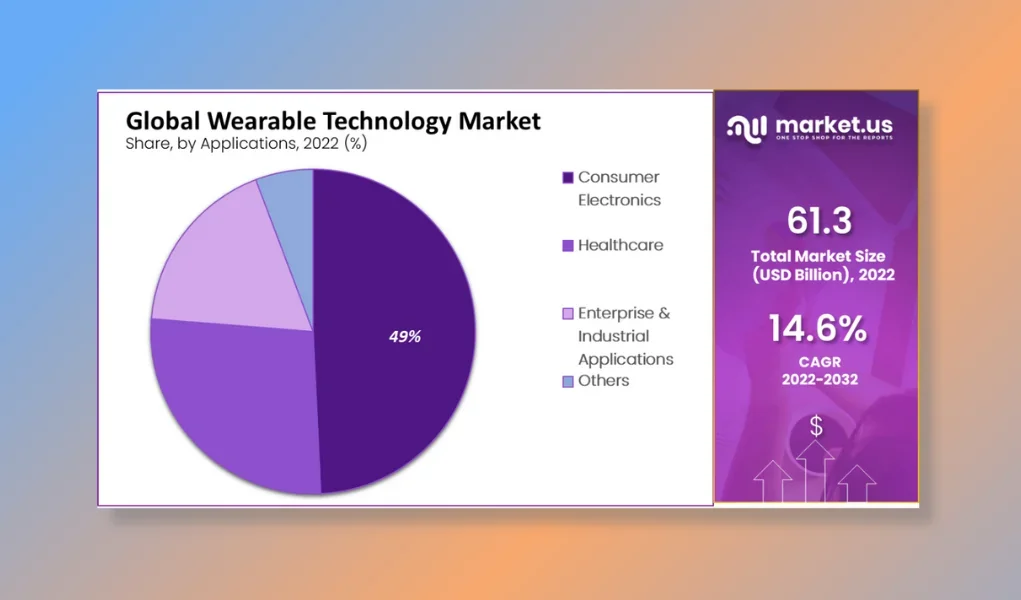
Why the Wearable Technology Trend Will Impact the Industry
The wearable technology trend is poised to revolutionize the health industry, driven by the portability and compactness of these devices. Smart healthcare IoT devices, such as smartwatches, fitness bands, and health-monitoring devices, allow users to track various health metrics seamlessly.
These devices enable individuals to monitor their physical activity, heart rate, sleep patterns, and other vital signs, promoting a proactive approach to health and wellness supported by advancements like AI in healthcare. As health awareness grows and the number of elderly people increases, wearable technology with wellness and fitness functions becomes a crucial driver in the market.
Trend #3: Telehealth Integration
Telehealth is a transformative smart healthcare IoT trend, utilizing digital communication technologies to deliver medical attention remotely. This includes virtual consultations, remote monitoring, and telemedicine applications that facilitate patient health care outside traditional healthcare settings.
The global telehealth market, valued at USD 102.7 billion in 2022, is poised for substantial growth, with an anticipated surge to USD 893.7 billion by 2032. This remarkable expansion is underpinned by a robust compound annual growth rate (CAGR) of 24.13%, as projected by Precedence Research.

Why the Telehealth Trend Will Impact the Industry
The telehealth trend is set to impact the industry significantly due to the substantial growth in market size, indicating a growing recognition of the value and effectiveness of remote medical care services. Technological advancements, increased connectivity, and a focus on accessible healthcare solutions contribute to the evolution of telehealth, positioning it as a crucial player in shaping the future of healthcare.
The rise in investments in IT infrastructure development and the widespread adoption of smartphones and internet connectivity, with around 4 billion people using the internet globally, further foster the growth of the telehealth market. Physicians and doctors are increasingly embracing telehealth platforms as a vital distribution channel for offering consultations and other medical services.
Trend #4: Smart Hospitals
A smart hospital represents a cutting-edge healthcare facility that utilizes state-of-the-art technology to enhance patient care, streamline hospital operations, and create a more efficient healthcare environment. This includes leveraging innovative tools such as IoT, Artificial Intelligence (AI), Big Data analytics, and automation to establish a highly connected and intelligent healthcare setup.
The global smart hospital market is expected to reach USD 283.3 billion by 2033, exhibiting a steady compound annual growth rate (CAGR) of 21.9% from 2023 to 2033. In 2023, the market was estimated to be USD 39.1 billion, as reported by market.us. The Hardware Segment dominates the Smart Hospital market, capturing a significant market share of over 40%.
This segment includes essential devices such as IoT sensors, medical gadgets, and connected systems crucial for gathering real-time patient health data, enabling remote monitoring by healthcare professionals, and ensuring the smooth operation of smart hospital setups.
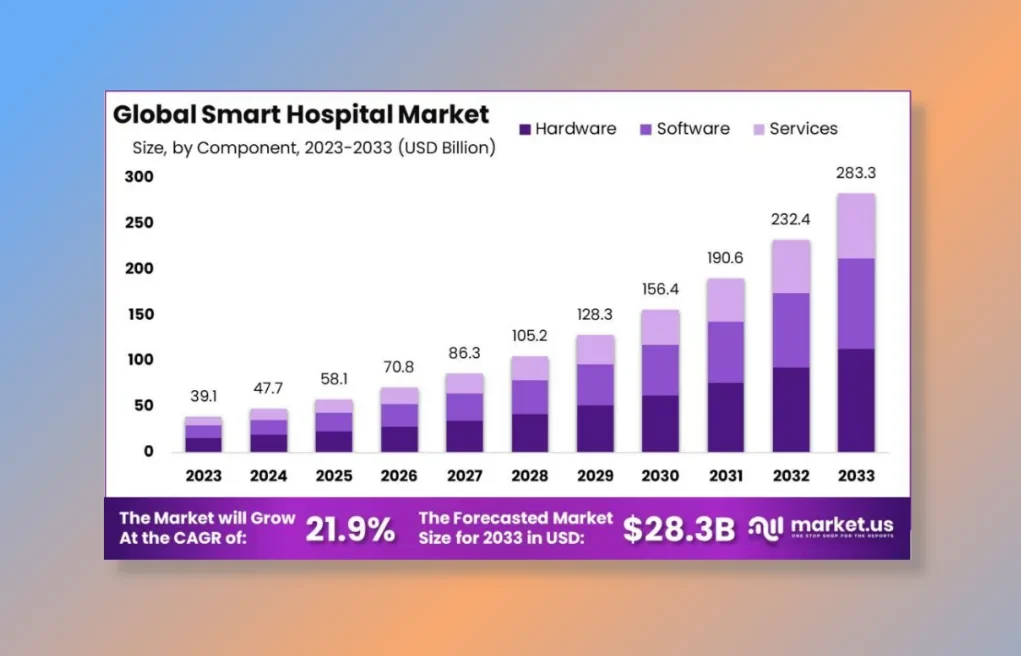
Why Smart Hospital Trend Will Impact the Industry
The Smart Hospital trend is poised to impact the industry significantly due to the comprehensive ecosystem it offers, comprising hardware, software, and services segments. Hardware components form the foundational infrastructure of smart hospitals, driving innovation and progress in healthcare delivery.
The dominant position of the software segment underscores its vital role in leveraging data analytics, electronic health records, and patient management systems, facilitating informed decision-making and personalized patient care.
Trend #5: IoMT for Chronic Disease Management
The Internet of Medical Things (IoMT) for chronic disease management represents using smart healthcare IoT devices and technology to monitor and manage chronic illnesses remotely. By leveraging advancements in sensor technology, miniaturization, and connectivity solutions, IoMT enables the development of sophisticated and affordable medical devices, making remote monitoring more accessible to health professionals and patients.
In the US market, the global IoMT market size was estimated at USD 144.23 billion in 2022 and is projected to grow at a compound annual growth rate (CAGR) of 20.4% from 2023 to 2030, as reported by Grand View Research. The advancements in sensor technology and connectivity solutions make IoMT more accessible and affordable, contributing to the market’s growth trajectory.
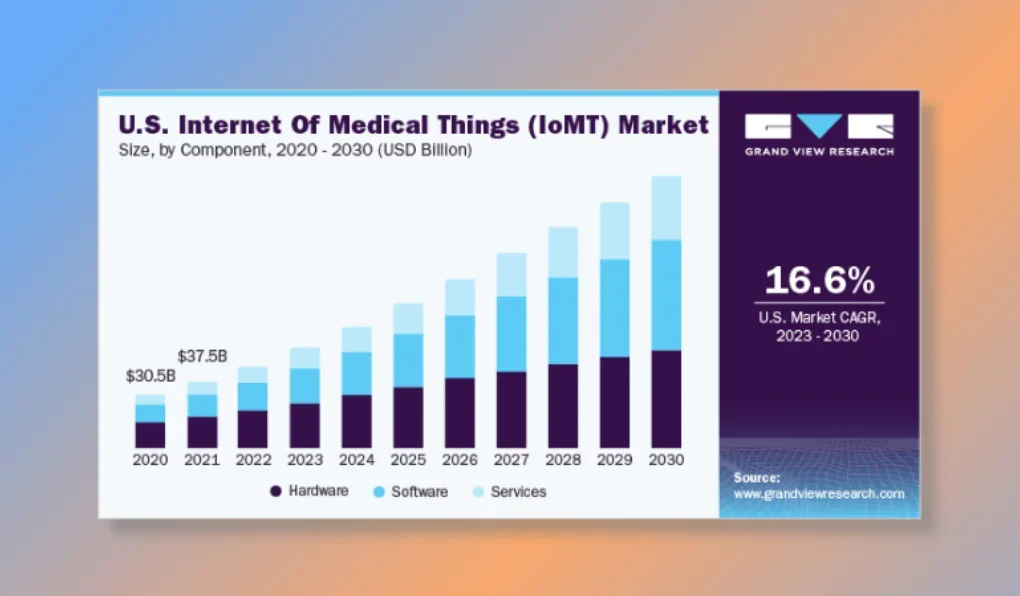
Why the IoMT Trend Will Impact the Industry
The impact of IoMT on chronic disease management is driven by the increasing prevalence of chronic diseases and the aging population, which necessitate greater demand for remote monitoring and healthcare management solutions. Integrating radio-frequency identification (RFID) tags in IoMT is pivotal in managing drug availability issues and supply costs, fueling market demand, and optimizing operations.
With key players continuously enhancing their product portfolios and expanding their geographical presence, the IoMT market is poised for significant growth, offering intelligent and precise healthcare delivery solutions to address the evolving needs of chronic disease management.
Trend #6: Virtual Reality in Healthcare
Virtual reality (VR) in healthcare integrates smart IoT solutions into patient medical treatment and medical training through immersive digital experiences. This innovative technology changes traditional healthcare practices by enabling medical professionals to use virtual environments for medical training, surgical procedures, disease awareness, and patient care management.
According to Data Bridge Market Research, the global virtual reality (VR) health market was valued at USD 2.89 billion in 2021 and is projected to reach USD 28.98 billion by 2029, exhibiting a remarkable compound annual growth rate (CAGR) of 33.4% during the forecast period of 2022-2029. This significant growth trajectory underscores VR’s increasing adoption and potential impact on healthcare worldwide.
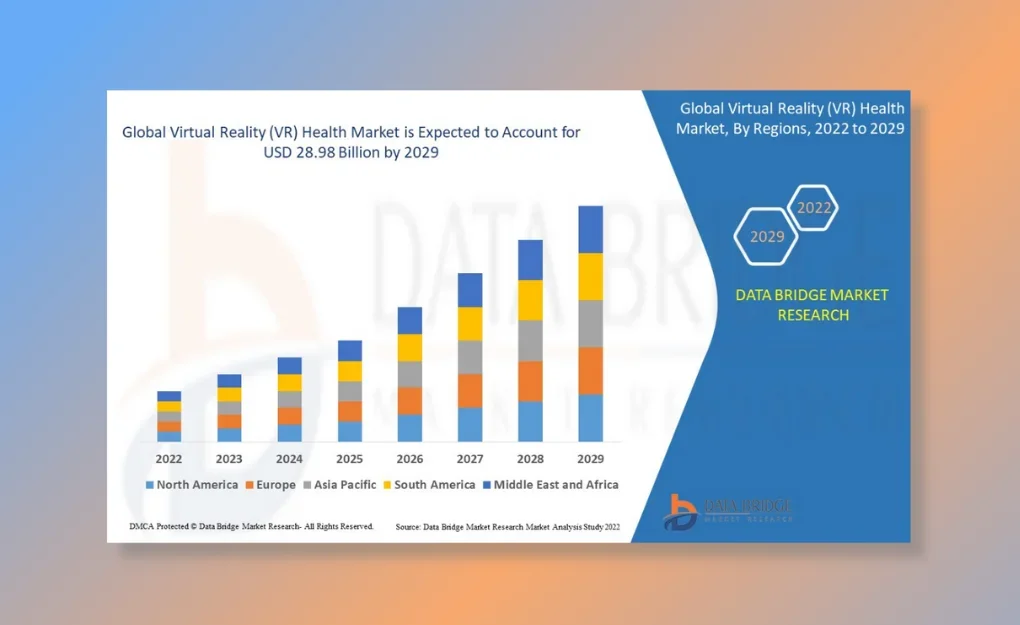
Why Virtual Reality in Healthcare Trend Will Impact the Industry
The trend of virtual reality (VR) in healthcare is poised to impact the industry significantly, driven by factors such as the increasing demand for advanced diagnostic techniques and the rise in health disorders. Data Bridge Market Research reports highlight comprehensive insights into VR’s market value, growth rate, segments, and geographical coverage, emphasizing its growing adoption and value recognition in healthcare.
Furthermore, the growing adoption and expansion of wearable devices in healthcare applications are expected to fuel the revenue growth of VR applications. Additionally, simulations in VR allow physicians and students to engage in virtual environments, recreating real-time, stressful, and life-threatening situations for training and skill enhancement, contributing to the widespread adoption of VR IoT technology in healthcare systems.
Trend #7: Blockchain in Healthcare IoT
Blockchain in smart healthcare IoT refers to integrating blockchain technology with smart healthcare IoT applications for data protection and enhanced patient outcomes. This trend involves using blockchain’s decentralized and immutable ledger technology to create transparent and secure systems for storing, sharing, and managing health information.
In the global market, the blockchain in healthcare market size was valued at USD 0.76 billion in 2022 and is projected to reach approximately USD 14.25 billion by 2032, with a compound annual growth rate (CAGR) of 34.02% during the forecast period 2023 to 2032, as reported by Data Bridge Market Research.
Blockchain technology has gained significant traction in the healthcare sector, especially amidst the COVID-19 pandemic, where its applications have been instrumental in ensuring the validity of vaccination certificates and enhancing the efficiency of healthcare supply chains.
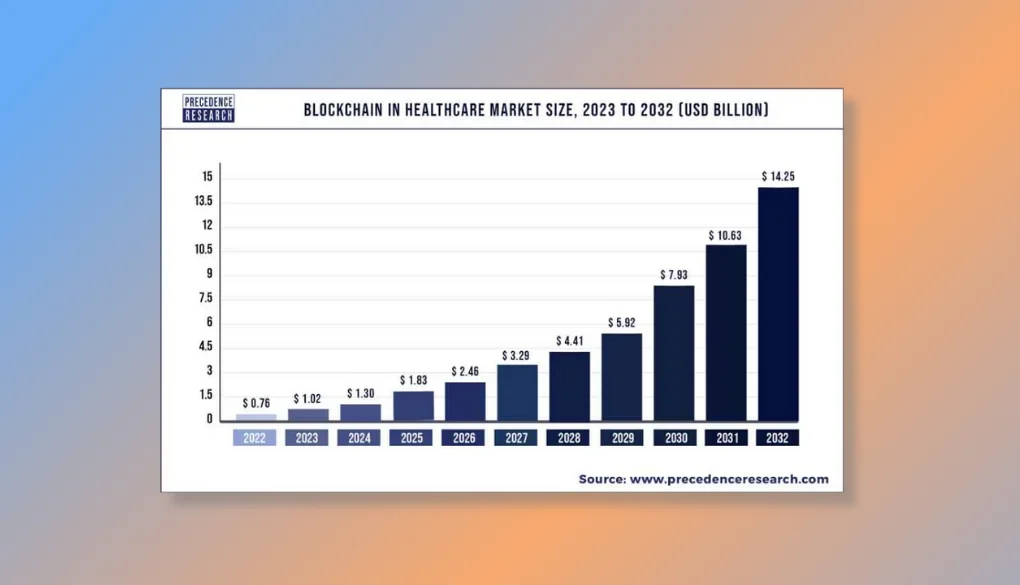
Why the Blockchain in Healthcare Trend Will Impact the Industry
The trend of blockchain in healthcare is poised to significantly impact the industry due to various driving forces and strategic measures taken by key stakeholders. With the rising frequency of data breaches and leaks, coupled with the growing need to address these problems, the adoption of blockchain technology is becoming increasingly essential.
Discussions and interest from major technological firms like Athenahealth, Allscripts, and Cerner indicate the potential for blockchain technology to revolutionize how companies who provide healthcare services approach enduring problems, ultimately driving further market expansion and adoption.
Trend #8: Hospital Asset Tracking
Hospital asset tracking involves the implementation of smart healthcare IoT solutions to optimize resource management within healthcare facilities. This trend utilizes advanced tracking systems and technologies to efficiently monitor and manage medical equipment, devices, and other assets. By leveraging IoT-enabled asset-tracking solutions, hospitals can minimize healthcare costs, enhance resource utilization, and reduce capital and rental expenses.
In the global market, the hospital asset tracking and inventory management systems market is projected to reach USD 23,650 million by 2029, witnessing significant growth from USD 18,880 million in 2022, with a compound annual growth rate (CAGR) of 2.8%, according to Valuates Reports. This growth reflects the increasing demand for effective asset tracking and management solutions in healthcare settings worldwide.
Why the Hospital Asset Tracking Trend Will Impact the Industry
The hospital asset tracking trend is poised to have a significant impact on the industry due to the continuous rise in global healthcare spending, which occupies 10% of the global GDP and is driven by factors like the aging population, prevalence of chronic and infectious diseases, and expansion of emerging markets.
With healthcare spending continuously rising, efficient hospital asset tracking becomes crucial in optimizing resource usage and enhancing healthcare delivery. As hospitals face growing pressure to provide high-quality care, adopting asset-tracking solutions is essential for addressing these challenges and driving sustainable improvements in healthcare delivery.
How to Stay Ahead of the Curve in Smart Healthcare IoT Trends
In the rapidly evolving landscape of smart healthcare IoT, staying ahead of the curve is essential for healthcare professionals and organizations seeking to harness the full potential of emerging technologies, especially for medical purposes. Here’s how to stay ahead of the curve in smart healthcare IoT trends:

1. Continuous Learning and Education
Continuous learning and education are paramount for staying ahead of the curve in smart healthcare IoT trends. Professionals in this field should seek opportunities to expand their knowledge by attending conferences, workshops, and webinars dedicated to smart healthcare IoT.
Additionally, online courses and certifications focused on emerging technologies like IoT, data analytics, and artificial intelligence in healthcare can provide valuable insights into the latest trends and advancements in healthcare technology. Moreover, staying updated on research publications, industry reports, and case studies can help professionals better understand successful implementations in the field.
2. Collaboration and Networking
Collaboration and networking are essential components for professionals seeking to stay ahead of the curve in smart healthcare IoT trends. Building relationships with peers, industry experts, and organizations fosters an environment of shared learning and innovation in implementing cutting-edge solutions.
Here are the key points to consider:
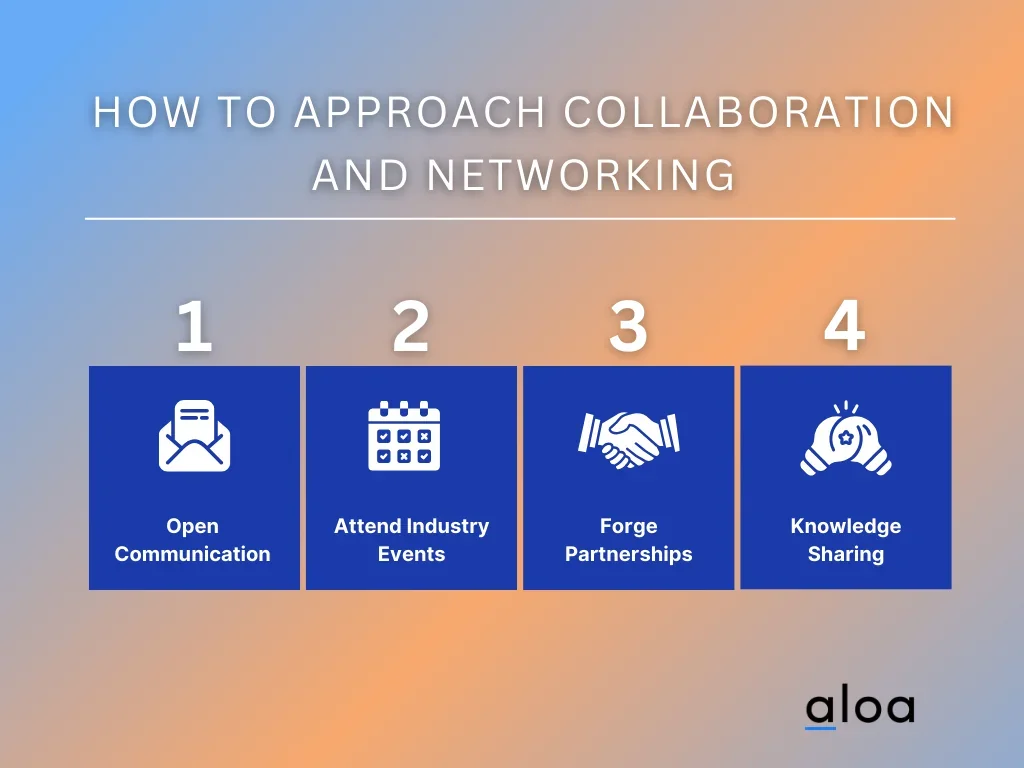
- Establish Open Communication Channels: Foster open communication channels with industry peers and experts to exchange knowledge and insights on smart healthcare IoT trends.
- Attend Industry Events: Participate in industry events, conferences, and workshops to network with key stakeholders and stay updated on the latest developments.
- Forge Collaborative Partnerships: Seek partnerships with technology providers, research institutions, and healthcare organizations to drive innovation and implement scalable smart healthcare IoT solutions.
- Engage in Knowledge-Sharing Initiatives: Actively participate in knowledge-sharing initiatives such as forums, webinars, and online communities to leverage collective expertise and accelerate learning in smart healthcare IoT.
3. Invest in Research and Development
Investing in research and development (R&D) is crucial for staying ahead of the curve in smart healthcare IoT trends. By investing in R&D, organizations can stay at the forefront of technological advancements, develop unique capabilities, and differentiate themselves in the competitive landscape of smart healthcare IoT.
Furthermore, R&D investments enable organizations to experiment with pilot projects and proofs of concept, allowing them to validate the feasibility and effectiveness of emerging technologies in real-world healthcare settings. Through strategic R&D initiatives, organizations can identify opportunities for optimization, uncover new market trends, and anticipate future demands in smart healthcare IoT.
4. Partnerships with Technology Providers
Establishing partnerships with technology providers is crucial for staying ahead of the curve in smart healthcare IoT trends. Collaborating with technology providers allows healthcare organizations to leverage their expertise and access cutting-edge solutions to enhance patient care and operational efficiency.
Here are the key points to consider:
- Identify Strategic Technology Partners: Evaluate potential technology providers based on their expertise, track record, and alignment with your organization’s goals and objectives.
- Foster Collaborative Relationships: Cultivate solid and collaborative relationships with technology providers to facilitate knowledge-sharing, innovation, and co-development of smart healthcare IoT solutions.
- Leverage Emerging Technologies: Partner with technology providers that offer innovative solutions leveraging emerging technologies such as IoT, artificial intelligence, and data analytics to address evolving healthcare challenges.
- Ensure Scalability and Compatibility: Ensure that the smart healthcare IoT solutions provided by technology partners are scalable, interoperable, and compatible with existing systems and infrastructure to support long-term growth and sustainability.
5. Data Security and Privacy Compliance
Data security and privacy compliance are critical considerations for staying ahead of the curve in smart healthcare IoT trends. Healthcare organizations must prioritize implementing robust security measures to protect sensitive patient data and ensure compliance with regulatory requirements such as HIPAA and GDPR.
Moreover, staying vigilant about evolving cybersecurity threats and emerging privacy regulations is essential for maintaining compliance and building patient trust. Healthcare organizations should regularly update their security protocols and policies to address new threats and regulatory changes, ensuring their smart healthcare IoT systems remain secure and compliant.
6. User-Centric Design
Adopting a user-centric design approach is essential for staying ahead of the curve in smart healthcare IoT trends. By prioritizing the needs and preferences of healthcare professionals, patients, and other stakeholders, organizations can create smart healthcare IoT solutions that are intuitive, user-friendly, and address specific healthcare challenges.
Here are the key points to consider:
- Understand User Needs and Preferences: Conduct thorough research to understand the needs, preferences, and pain points of healthcare professionals, patients, and other stakeholders using smart healthcare IoT solutions.
- Design for Ease of Use: Prioritize simplicity and ease of use in designing smart healthcare IoT solutions to ensure users can easily navigate and interact with the technology.
- Incorporate Feedback and Iteration: Continuously gather feedback from end-users throughout the design and development process and iterate on the design based on user input to ensure that smart healthcare IoT solutions meet their evolving needs.
- Test and Validate: Conduct usability testing and validation with end-users to identify any usability issues or areas for improvement and refine the design accordingly to enhance user experience.
7. Monitor Industry Trends and Market Dynamics
Monitoring industry trends and market dynamics is essential for staying ahead of the curve in smart healthcare IoT trends. By keeping a close eye on emerging technologies, market shifts, and regulatory changes, healthcare professionals can anticipate future trends and adapt their strategies accordingly.
Furthermore, actively participating in industry forums, conferences, and networking events enables healthcare professionals to exchange ideas, share best practices, and gain valuable insights from peers and industry experts. Organizations can stay abreast of the latest developments and identify emerging trends by connecting with key stakeholders and thought leaders in the smart healthcare IoT space.
Key Takeaway
Staying ahead in smart healthcare IoT trends is essential for healthcare professionals and organizations looking to innovate and enhance patient care. As trends in healthcare software systems continue to evolve, staying informed and proactive in embracing smart healthcare IoT trends will be crucial for driving innovation and delivering superior healthcare experiences.
At Aloa, we pride ourselves on staying at the forefront of industry trends, ensuring that our solutions are always up-to-date with the latest advancements in health tech. With our commitment to continuous learning and innovation, you can trust that Aloa is equipped to meet your healthcare technology needs with cutting-edge solutions.
Sign up for our email list through our blog page to stay updated on the latest trends in the HealthTech industry. We’ll post our latest insights and updates to help you keep ahead of the market trends.
Sign up to our email list to stay updated on the latest trends in the HealthTech industry. Join us at https://aloa.co/blog to stay informed

